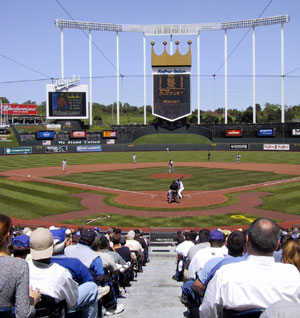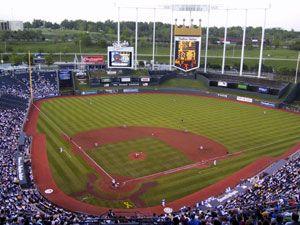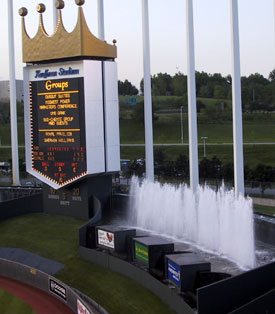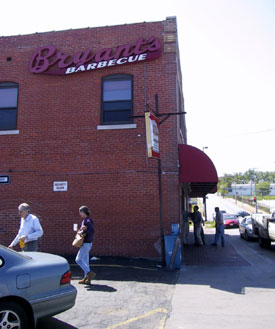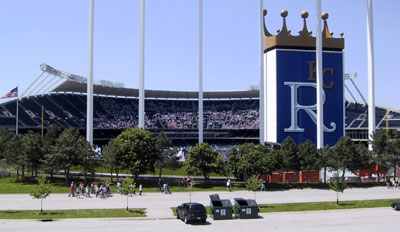 |
 |
|
|
|
|
|
|
|
|
|
|
|
|
|
|
|
|
|
|
|
|
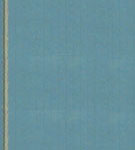 |
|
Sox On The Road: Kansas City
I managed to make my first ever visit to Kansas City coincide with the Red Sox’ annual trek into the western Missouri city of 1.9 million synonymous with jazz, barbeque, and even baseball after the Royals sprinted off to the best home start of any MLB club since 1911.
The first thing you’ll notice as you fly into KCI is that the airport is far away…from anything. It’s located as far away from its namesake city as any airport I’ve ever been to, approximately 20 miles to the northwest of downtown Kansas City, accessible by I-435 and I-70. After getting an eyeful of grass and the otherwise lack of development nearby, I realized that all rental car companies are located off-site, which required a shuttle ride. Take into consideration the distance between airport and city, and add in the fact the ballpark is east of downtown, and it doesn’t take much to figure out a rental car is a must. There is no public transportation worth mentioning in KC. I was very surprised at the high price of temporary transportation when I searched the Internet the night before my trip. Hertz and Avis had outrageous daily rates of $100, which made my selection of Enterprise and its $38.59 rate for a compact seem like the steal it really wasn’t, considering I had just rented a car on no notice in another country (Panama) from Avis at $23 per day. Previously I had booked a car online through Hertz in Boston at $19 the night before. After adding another $8.90 worth of daily taxes onto the final total ($94.98 for two days), I headed for downtown in a red four-door Ford Escort. It didn’t take long to hit road construction and soon after I had to alter my direct route into the city when I discovered that I-70 was closed, for reasons unknown, although I figured it had something today with the tornadoes and other bad weather that had devastated the region two days before. Shortly afterward I realized that the airport basically straddles the Kansas and Missouri state lines, and I found myself driving through the Jayhawk state for 10 or 15 minutes. I always get that weird feeling in my stomach when I find myself suddenly entering another state without intending to be there, but before too long I found myself saying “I’m not in Kansas anymore,” which was reason enough to get sidetracked. My first impressions of the Kansas City area consisted of wide-open spaces and road construction. When I made it to downtown not much had changed. Although it has its fair share of big buildings, Kansas City isn’t overwhelming in its size and you could drive through it in a couple of minutes. With an afternoon to kill before a night game, I went to the historic district at the intersections of 18th and Vine Streets, renowned for its music, food, and birthing of the Negro League baseball. I lunched at Ronnie Sander’s Catfish Cabin, where for $7.05 I had a large piece of my favorite fried fish along with choice of two sides (cheese fries & coleslaw). The food was good, but nothing extraordinary. A few paces down from the restaurant were the Museums of 18th and Vine, one of which housed the Negro Leagues Baseball Museum. The museum opened in 1991 to pay homage to the history of the Negro Leagues, and does not serve as a Hall of Fame. Kansas City was a natural choice of host due to its heritage as the birthplace of the Negro Leagues, which were officially organized by Rube Foster in the nearby Paseo YMCA in 1920. The Museum chronicles the history of African Americans in professional baseball through the late 1800’s up until Jackie Robinson broke the color barrier in 1947. Although the self-guided tour generally takes an hour (according to the pamphlet), I spent three hours inside. A 15-minute movie narrated by James Earl Jones runs every half hour and precedes the exhibits, which detail the six different Negro Leagues, the famous East-West All-Star classic, and the legendary players that made up the rosters. Among the more memorable pieces of information that I retained centered around Hank Aaron, who was nicknamed “Pork Chop” during his Negro League career with the Indianapolis Clowns. Apparently as a teenager, Aaron would only eat pork chops and french fries while the team traveled. Additionally I learned that, although there was a league structure, Negro League teams played a majority of their games against local teams as they barnstormed across the county. The first-ever night baseball games occurred in 1930 when the Kansas City Monarchs purchased a portable lighting system, enabling them to play at night wherever they went. It wasn’t until 1935 that MLB first played under the lights, when the Reds hosted the Cardinals at Crosley Field. I found the Negro Leagues Museum, which shares a complex with the American Jazz Museum at 1616 East 18th Street, to be very informative and highly recommend it to any baseball fan. Admission is only $6 and parking is free and easy to find in a nearby lot or on the street. The hours of operation are 9-6, Tuesday through Saturday, and 12-6 on Sunday. After spending an afternoon reveling in baseball’s past, I traversed the short distance between the Museum and Kauffman Stadium on I-70, where the Red Sox and Royals met in the second game of a three game series. As it turned out, the Royals had an opportunity to tie a 92-year old record for the best start at home with a victory. The 1911 Detroit Tigers started the season 12-0 at Bennett Park, while Kansas City entered the evening an unblemished 11-0 at the ballpark locals refer to as “The K.” From the interstate, my initial view of Kauffman Stadium was quite impressive. From I-70 I could see the entire upper deck of the ballpark and the large Royals logo on the back of the scoreboard, which is shaped like the classic logo itself. Majestic as ever, The K shares a sports complex with the Chiefs’ Arrowhead Stadium. Exiting I-70 at the Blue Ridge Cutoff, I descended down to where the stadium is situated. The Missouri Welcome Center is also on the same exit, and the key to parking is going to the stadium lot entrance past the Welcome Center. If you turn off at the first entrance when exiting the Interstate you’ll have to wait in a lengthy line to park in the same lot that has a pair of entrances just past the Center. Skipping the longer line, the stadium parking was a breeze and perhaps the only official ballpark lot not yet a rip-off. Priced at a modest $6, I parked my car less than 100 yards from the Stadium. I can’t think of another MLB ballpark that I’ve visited where I was able to park as close as I did for under $10.
The Royals were established as a MLB expansion franchise in 1969, and after spending their first four seasons at Municipal Stadium they moved into Royals Stadium in 1973. The biggest change to the stadium since then has been its renaming in 1993 after their late-owner, Ewing M. Kauffman. Two years later, the Royals replaced the original artificial turf with real grass, and during the decade all of the seats were painted blue, replacing their original orange color. In line with parking costs, tickets remain cheap in comparison to their MLB brethren, ranging from $5-22. All the seats offer an excellent view of the playing field, although I opted to sit in the upper deck for Tuesday night’s game in order to take in the view of the ballpark’s surroundings, which can only be obtained from sitting in the second deck. Apparently Kansas City managed to master the art of the non-closed open-air stadium before they became chic. While most of the newer stadiums offer views of city skylines and the like, at The K you get a view of the elevated I-70 and automobiles zooming to and fro, in addition to the waterfalls behind the outfield walls. But to me, the dominant feature is the eyeful of green grass, reminiscent of Spring Training berm seating, that extends outside the ballpark up to the highway.
While watching the Red Sox thwart the Royals’ attempt at tying the record, I began to feel the chill as night began to fall, and it appeared the wind was emitting from the Interstate above the playing field. Ushers at the K are friendly and not very inquisitive when it comes to ticket stubs, so if you are in town you can buy a $5 ticket and move about the ballpark freely. As a result, I spent the last few innings watching the game behind the left field seats that extend the 75 feet or so from the foul pole. The concourse area behind the seats was a cool place to hang out, watch the rest of the game, and a great place to mingle with other fans, who general were very into the game. As for ballpark fare, I had a tasty brat for $5.25 and the cola of choice is Pepsi ($3.50 in a souvenir cup). In addition to the standard concessions, The K has a Kristy Kreme stand and a Gates BBQ on the lower concourse. The souvenir of choice is a $15 t-shirt with the Royals 2003 motto written in English (Believe) and Spanish (Nosotros Creemos). After being among the 15,848 watching Boston hold off Kansas City 7-3, I easily exited the parking lot and got back on the Interstate where a handful of hotels were priced in the $36-45 dollar range in the vicinity off of nearby I-435. Although rental car prices were inflated, I was happy to find a Motel 6 seven miles away at $35.99, and lodging fell within my target price range. From what I could gather, nightlife in KC is rather limited, especially mid-week. The place to be for bars and the like is the Westport neighborhood. Other distractions include the riverboat casinos that popped up on the Missouri River six years ago, led by Harrah’s, which reportedly profited $120 million last year from their KC location. On Wednesday, May 7 I began the day by mixing a little bit of work in with my pleasure, meeting with the Master Pitching Machine Company, a vendor of a company I work for. They specialize in the arm-style pitching machines used by all of the MLB teams, and many others, in addition to private individuals. I was fortunate enough to be able to use the company’s season tickets and parking pass for the afternoon game, one of those aptly titled businessperson specials. But before MLB baseball came BBQ, and no barbeque joint is more famous than Arthur Bryant’s, which has hosted the likes of former Presidents Jimmy Carter and Harry Truman. Located at the corner of 18th Street and Brooklyn Avenue (behind the Catfish Cabin) and within sight of the Negro Leagues Museum, Bryant’s has been serving up Kansas City’s favorite dish in their original location since 1930. Although KC boats numerous barbeque restaurants and sauces, a trip to Arthur Bryant’s is a must.
Each table has two bottles of sauce on it: original and rich & spicy. Although I wasn’t impressed with the thin, sour-tasting original sauce, the thicker rich & spicy may be the best barbeque sauce I’ve ever tasted. After finishing lunch, I bought an 18 oz. bottle of it for three dollars. For those interested in the taste of Kansas City, you can purchase 3 and 12-packs of Bryant’s sauce online at http://www.arthurbryantsbbq.com. Arthur Bryant choose the location because of its proximity (4 blocks) to Municipal Stadium, the original home of the Royals, Chiefs, and Kansas City A’s prior to their move to Oakland. Although Kauffman Stadium is 7 miles away, the famous restaurant is still the perfect place for a pre-game meal. On a perfect Wednesday afternoon that doubled as School Day at The K, the Red Sox rallied from a 6-1 deficit in the seventh inning to a 9-6 victory before a boisterous crowd of 28,268. Former Royal star Johnny Damon did in his old team with a two-run homer and double. Kansas City fans booed loudly every time Damon stepped to the plate, even though it has been three years since he was traded to Oakland after turning down a contract extension. On the flip side, the loudest cheers went to Royals slugging 1B Mike Sweeney, who’s 5-year, $55 million contract can be voided if the Royals don’t finish above .500 either this year or in 2004. Sweeney is as beloved in Kansas City as Dale Murphy was during the ‘80’s in Atlanta and just as religious, the perfect blend of superstar and role model toiling in near anonymity on the normally underachieving Royals, who have the second lowest payroll in the majors. Considering Sweeney’s beliefs, it’s slightly ironic that the headquarters of the Fellowship of Christian Athletes is the most noticeable building looming on the horizon, rising above I-70 in left field.
After the game I went over to the Royals Hall of Fame exhibit, which is housed slightly to the third base side behind home plate. Each of the Royals six division championship trophies are displayed, as is the holy grail of the sport, the World Series trophy from 1985. The Royals began their own Hall in 1986 and have inducted 18 former players and managers, the first of which were Amos Otis and Steve Busby. The most famous of all players to don Kansas City blue remains George Brett, who is one of three Royals to have their numbers retired by the team (Frank White and Manager Dick Howser are the others). The numbers are located below the scoreboard in center field. Underscoring Brett’s status, the George Brett Bridge is located next to Kauffman Stadium. After the game I made the 28-mile trek back to the airport, where I dined on an above average plate of nachos at the Boulevard Brewing Company. If beer is your thing, then Boulevard is your local flavor, now offering four choices 14 years after the brewery’s inception in downtown. And at that my trip to Kansas City was complete. About the only thing I missed was the legendary jazz music, but the baseball and barbeque mix was the perfect recipe for a quick get-away. As for Kauffman Stadium, it remains a gem cut from the same cloth as Dodger Stadium, but there has been some talk concerning a new downtown ballpark. But Kansas City’s downtown isn’t the bustling center of activity found in many other major league cities, and the Royals should remain in the K for as long they “kan.” It’s not a trip you can do on the cheap, but a visit to Kansas City is definitely worthy of any baseball fan, especially when the Red Sox come to town.
|
